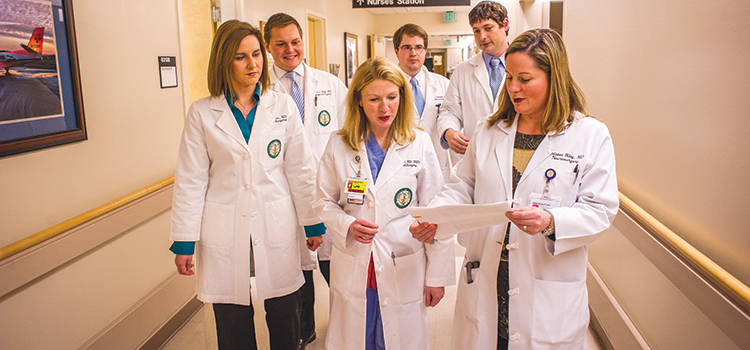 The formalized, structured curriculum centered upon the six ACGME core competencies outlined/defined by the ACGME and the seven major sub-specialty areas within neurosurgery. We utilize didactic teaching, self-directed learning, computer-based education, anatomic cadaveric dissection, and apprentice experiences to enrich each resident’s educational experience.
The formalized, structured curriculum centered upon the six ACGME core competencies outlined/defined by the ACGME and the seven major sub-specialty areas within neurosurgery. We utilize didactic teaching, self-directed learning, computer-based education, anatomic cadaveric dissection, and apprentice experiences to enrich each resident’s educational experience.| PGY-1: Clinical Neurology (3 months) Clinical Neurosurgery (6 months) Critical Care (2 months) Trauma Surgery (1 months) |
PGY-5: Research Year (12 months) |
| PGY-2: Vascular Service (4 months) Tumor Service (4 months) Spine Service (4 months) |
PGY-6: Elective Adult Neurosurgery, Senior (12 months) |
| PGY-3: Pediatric Neurosurgery (4 months) Veterans’ Administration (4 months) Adult Neurosurgery (4 months) |
PGY-7: Chief Residency (12 months) |
| PGY-4: Vascular Service (4 months) Tumor Service (4 months) Spine Service (4 months) |
Medical Evidence-Based Curriculum
Formalized didactic training in interpretation of medical evidence is directly incorporated into the resident curriculum. Experienced faculty coordinate this initiative and conducts a monthly medical evidence conference and a resident-led journal club. The purpose of this initiative is to teach the resident-in-training how to systematically and critically appraise scientific papers in the medical literature with regard to study design, bias, validation of assessment, common types of errors, and introductory statistical assessment. The residents are introduced to these concepts through a standardized curriculum. The residents then use these concepts to direct our monthly journal clubs according to contemporary standards of evidence-based medicine.
Faculty and Resident Publications
As part of this training, UAB Neurosurgery residents conduct numerous resident-directed research studies. Click here to view the full list of faculty and resident publications.
Evidence-Based Medicine: Development of Clinical Guidelines
Drs. Mark N. Hadley, Beverly C. Walters, and other faculty members including Dr. Mark Harrigan and Dr. Curtis Rozzelle within the Department of Neurosurgery have published multiple compilations of medical evidence-based guidelines for neurosurgical disorders. The guidelines were developed with the support of the Joint Section on Disorders of the Spine and Peripheral Nerves of the American Association of Neurological Surgeons and the Congress of Neurological Surgeons.



